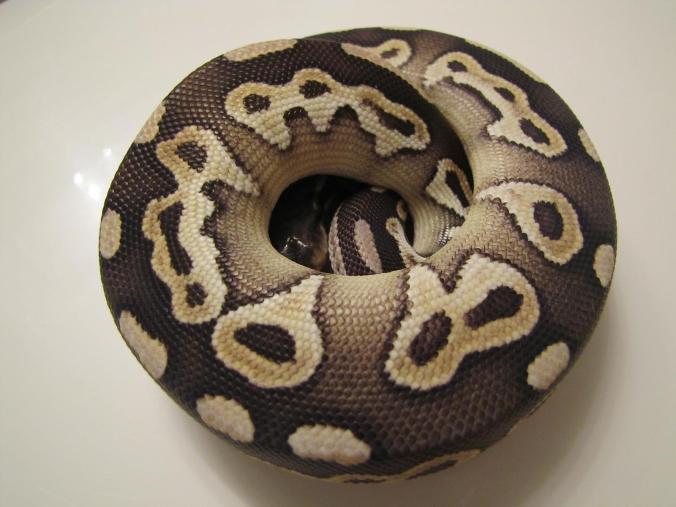As you remember, I recently did a post of defensive techniques snakes use to warn us and ultimately avoid conflict. This is a continuation on that as there are a few more worth discussing.
6. Ball Technique
A manoeuvre made so well known by the Royal Python, they now are better known by their very suited nickname, Ball Python. These little guys are quite head-shy, meaning, as soon as is seems their head could get damaged or hurt, they curl into a tight ball that envelops and hides their head away. Though there are feisty ball pythons, these little ones are mostly shy and not as defensive, making great pets, specially for first time snake keepers!
7. Hooding

Spectacled Cobra. Image Source
This specific tactic only refers to Cobras as well as the Rinkhals (though it is considered a Cobra, it is not a true Cobra, but still falls within the same family – elapidae). As a warning to oncoming predators and anything perceived as a threat, the muscles in the Cobras neck will raise elongated ribs to flatten and display the hood, keeping the skin taught, and grabbing the attention of any passing creature, raising its body off the ground and giving a clear visual warning. King Cobras are able to look a full grown man in the eyes.
8. Spitting

Mozambique Spitting Cobra. Image Source
Though this is a more harsh warning mechanism, it will ultimately be better than a bite. Reffering now to only spitting cobras and, again, the Rinkhals. Once it seems the hooding technique is failing and the unwanted visitor is now moving a bit too close for comfort, these snakes will spray a stream of venom directed for the eyes of its victim. This is still considered a warning, as, though they do now have to give up some of their venom, it will ultimately not kill anyone, only used for creatures larger than itself, and when washed off, will only be left with eye irritation for a short while. Ultimately, the snake is still less at risk spraying than biting, as that is a physical attack that will often end in a retaliation from the opposed.
9. Coiling

Brown Tree Snake. Image Source
We are all familiar with this position, you know the one, where the snake is preparing for a strike – a little nip at you. Now this is also in itself a warning. They are visually showing you that if you do not back away and respect their space, they are ready to strike at you, and will do so if necessary.
All they want is for you to just step back, they need space and they don’t see you as inquisitive. All they see is a rather large heat signature approaching them, so it is most probably a predator.

Aww! I get goosebumps while reading this post.
LikeLiked by 1 person
I hope in a good way!😅
LikeLiked by 1 person
Of course! 😊
LikeLiked by 1 person
I really fear of the snake. But I still like to read to know more about this creature.
LikeLiked by 1 person
Well I’m glad you still enjoy reading about them! Snakes aren’t for everyone😊 I just like spreading the knowledge!
LikeLiked by 1 person
♡ Thank You
…♡♡♡…
LikeLiked by 1 person
Noted!
LikeLiked by 1 person
♡ Just watched ‘Spiderman’, a Spider/Human Hybrid, SupaSoulSis The Reptile Queen and I Had a Revelation; it’s Crystal Clear Clarity that I AM a Human/Snake Hybrid along with Being Black Central African who, despite also Being Aussie, is comfortable with an effectively Second String Boks Team Scoring a comfortable victory…so I THINK!!! I AM a Supreme Serpent like, say for example an Emperor or Lilith, The Serpent in The Garden Of Eden; and Other ‘Lesser’ Snakes HATE!!! Me 😣 AM I Mad 🤔 ?
…♡♡♡…
LikeLike
Thanks for sharing your knowledge. It’s one thing to open a textbook and read this information, then subsequently to forget it all too quickly.
Quite another, though, to take in what experience has taught you. “Hey, wait, I “know” the person writing this!”
Interesting, too, to see other creatures apply these mechanisms. Curling into a ball? Pangolins, pill bugs, hedgehogs…
Rearing up and spreading the hood, as cobras do, to make themselves appear bigger? Isn’t that what cats do when they arch their backs and puff out their tails?
LikeLiked by 1 person
Thank you so much! I’m glad I can share this knowledge and people actually find it somewhat fascinating!
Exactly! People see a lot of these signs as menacing, but meanwhile, they are just like any other animal giving a fair warning to keep themselves safe.
I am glad I have made this information a bit more memorable for you, and I completely understand what you mean when you say gaining knowledge from a person whom you “know”.
LikeLiked by 1 person
Beautiful cobra head. We don’t have that many venomous snakes and those are mostly shy or warn you with a rattle. The exception is the coral snake and it is rare.
LikeLiked by 1 person
Ah, the coral snake! I would love to see one some day!
LikeLiked by 1 person
Run away!
LikeLike